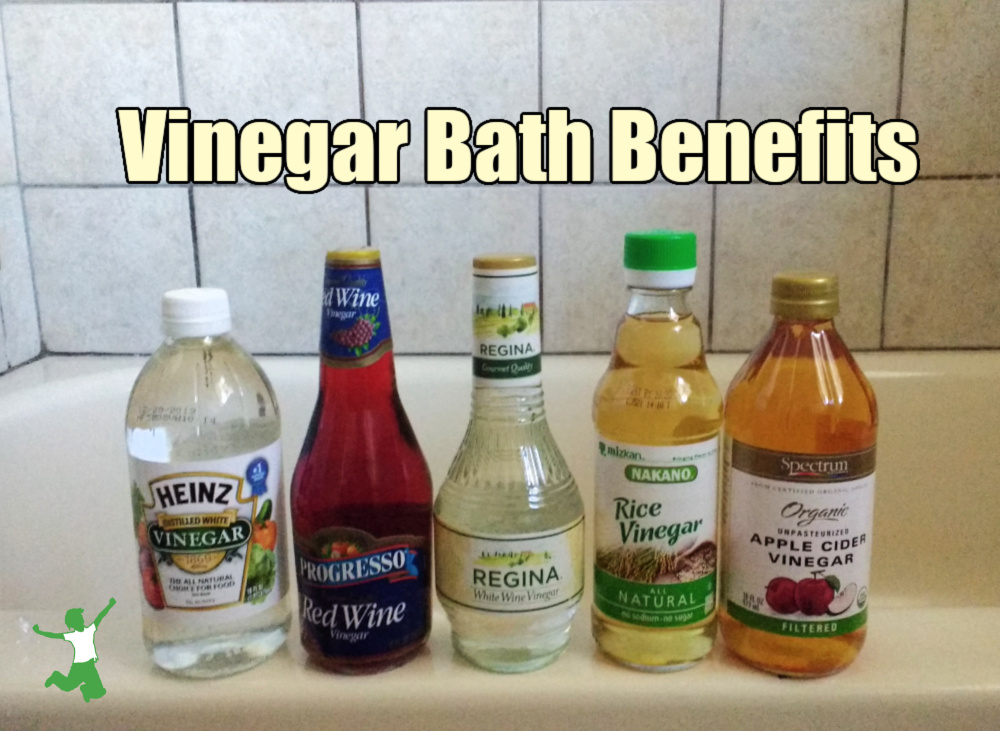Table of Contents[Hide][Show]
In-depth discussion of which types of vinegar to consider for therapeutic baths including a step-by-step guide on how to optimize a full-body vinegar soak and how often to enjoy one to improve skin pH, overall health, and wellness.

This is the time of year when many people choose to adopt a regular regimen of detoxification bathing, sensible exercise, and dietary modifications to improve health.
When it comes to internal cleansing, a vinegar bath is one of the most all-around beneficial therapies according to Dr. Hazel Parcells, who herself lived to the ripe old age of 106. Obviously, she was doing something right!
Depending on the type of vinegar selected for a detox bath, it can also be an extremely affordable choice as well.
Benefits of a Vinegar Bath
The reasons for a regular vinegar bath are simple: this holistic therapy is a great overall detoxifier especially for muscle aches and pains brought on by physical exertion.
A vinegar bath is also helpful and the best detox bath choice for those with candida issues that affect the skin. This is because bathing in water with a small amount of vinegar returns the skin to an optimal, slightly acidic pH which is a difficult environment for candida and other pathogens to thrive.
Most importantly, the acidity of a vinegar bath draws excess uric acid out of the body. Uric acid is created when the body breaks down substances called purines in certain foods and drinks.
While most uric acid is easily eliminated by the kidneys, some people such as those prone to gout can have issues with excess levels from time to time. A vinegar bath can provide welcome relief for those with any sort of joint problems, not just gout, including arthritis, bursitis, or tendonitis.
A regular vinegar bath is very helpful for those with excessive body odor problems too. Be sure to soak those armpits while in the bath and you will no doubt notice a substantial improvement immediately.
Toxic Vinegar to Avoid
Before we talk about the various types of vinegar that can be considered for a cleansing vinegar bath, let me just suggest one very important tip about sourcing your vinegar.
Always use vinegar in glass!
The reason it is important to source vinegar in glass containers is because vinegar is highly acidic and can have a pH as low as 2.4 as in the case of white distilled vinegar. Remember that the pH scale runs from 0-14 with 7 being neutral (water). So, a pH of 2.4 is clearly acidic and considerably so!
Acidic liquids stored in plastic have the very real potential of leeching undesirable chemicals out of the container and into the liquid itself – – in this case, the vinegar.
Plastic is not a suitable container for any type of vinegar.
Those of you who are familiar with the fermentation of traditional beverages will no doubt remember that the popular drink from Russia known as kombucha is supposed to be stored in glass as well, and a properly brewed batch of kombucha has a pH of around 3.5 which is slightly less acidic than white distilled vinegar.
GMO Vinegar
Another important consideration is that is how the vinegar is made. White distilled vinegar that is not organic is usually made from genetically modified (GMO) corn that has been heavily sprayed with pesticides, so it is best to only choose organic if this is the type of vinegar you favor.
In addition, given that the FDA has approved the cultivation of GMO apples, cider vinegar that is not organic will likely be a GMO product in the future, so best to stick with organic for this type of vinegar too just to be on the safe side.
Therefore, be sure to select vinegar for bathing that is stored in glass and is non-GMO when you commence a detoxification regimen that includes regular vinegar baths.
Attempting to detox in a bath where the vinegar is likely compromised with chemicals and/or pesticides kind of defeats the purpose, don’t you think?
Now, on to the types of vinegar and which one might be best for you for improving and maintaining health.
Vinegar to Consider for Bathing
Vinegar has been made and used by humankind for thousands of years. Traces of it have been found in Egyptian urns discovered during archaeological digs dating back to 3000 BC.
The vinegar used historically in a given culture tends to reflect the plants available in that region. Hence, there are many types of vinegar that still remain popular today for all manner of purposes.
For example, countries known for making wine, such as France, Italy, and Spain, produce wine vinegar. North America produces apple cider vinegar as apples are a main crop on this continent.
Countries that brew beer such as Great Britain, produce malt vinegar. In Asia, where wine is made from rice, locals favor a milder variety of rice vinegar.
I’m not going to review every single type of vinegar that is available to use for therapeutic bathing in this article. Instead, I will focus on the main types that are readily available for a reasonable cost at the supermarket.
- Homemade apple cider vinegar (ACV) or store-bought (raw and always packed in glass)
- White distilled vinegar (nonGMO)
- Wine vinegar
- Rice vinegar
Not All Types are Suitable
Note that not all vinegar is suitable for detoxing. For example, avoid using balsamic vinegar for bathing. The pH of this vinegar is much less acidic (pH of 4) than others. This characteristic is due to its years-long fermentation, resulting in a sweet taste and smell.
This is a good thing for the budget since balsamic vinegar is typically one of the most pricey!
By comparison, the vinegar bottles pictured above were all purchased at my local grocery store. The cost for these five bottles (16 oz each) was a little over $15.
Very cost-effective indeed!
Top Two Vinegars for Bathing
The most important piece of information about the vinegar you choose for bathing is the pH. You can buy inexpensive pH strips and test yourself as desired.
Apple cider vinegar is one of the mildest kinds of vinegar you can choose for bathing with a pH of about 4-5. This is why it is so often recommended for vinegar bath purposes.
The next mildest is rice vinegar, wine vinegar, and finally white distilled vinegar which typically tests at a 2.4 pH.
pH is very Important
The strength of the vinegar, i.e., the amount of acetic acid diluted in water, is also an important piece of information. To be called “vinegar”, the liquid must be at least 4% acetic acid by volume.
Typical store-bought vinegar has a dilution strength of 5%, but wine vinegar can sometimes go as high as 7%. Just check the label and it will tell you the strength of that particular bottle.
The five bottles in the picture above are all 5% strength with the exception of the rice vinegar which is 4.2%.
Smell and Flavor
A major difference between various types of vinegar is the smell and hence the flavor (if you use them for food).
Since the sense of smell varies considerably from person to person, the type of vinegar you select for bathing purposes will be the one that you find the most pleasant (or least offensive) as the case may be.
I carefully smelled each of the types of vinegar pictured above. I found the white wine vinegar to be the mildest by far. The rice vinegar, surprisingly, was the strongest smelling of all.
Vinegar Substitutes (if You Are Sensitive)
Can’t stand the smell of any vinegar? Then you can substitute pure lemon juice with no additives for your vinegar bath instead, although this is definitely the more expensive way to go.
Which to Choose?
So which vinegar to choose for bathing? It’s really up to you.
The goal of a vinegar bath is simply to raise the acidity of the water. This encourages a therapeutic effect for the skin as it draws out toxins. Thus, any vinegar will do.
However, note that white distilled vinegar is a lower pH than apple cider vinegar. So, if you have very sensitive skin, it is probably best to stick with the tried and true ACV bath.
If the smell of apple cider vinegar poured into the bath is just too strong for you, try a milder-smelling vinegar or lemon juice. Your nose will tell you which one will work best!
How to Take a Vinegar Bath (step by step)
Taking a vinegar bath is so very simple.
Add 2 cups of vinegar (or lemon juice) of choice (this is the brand I use although I buy others when they are on sale) to a regular-sized tub of water as hot as comfortably tolerated. Use more as needed if your tub is oversized. If using a foot bath, use one-half to one cup.
Stay in the bath for at least 20 minutes and ideally until it has cooled to close to body temperature which will be about 45 minutes. Use this time to totally relax!
Step out of the bath and towel dry.
Don’t shower or even rinse off for at least 8 hours in order to maintain the slightly acidic effect of the vinegar bath on the skin in order to maximize benefits.
Remember – water has a neutral pH of 7 so even just rinsing off will reduce the positive health effects of the vinegar bath to the skin. Don’t worry — you won’t smell like vinegar! The skin smells surprisingly sweet, refreshing, and very clean after a vinegar bath.
Enjoy! Healthy can and should be a pleasant journey.

More Detox Information
Hydrogen Peroxide Bath for Healing Skin Infections
Epsom Salt Bath Benefits
7 Ways to Avoid Detox Symptoms on a Cleanse
Top 4 Cleansing Myths to Watch Out For
Coffee Enema: Unmatched Detoxification for Health and Recovery
Natural Deworming Methods that are Safe and Effective
Using a Fever Bath to Hasten Healing
Seaweed Wrap: Minerals In, Heavy Metals Out
How to Gently Detox in Preparation for Pregnancy
Detoxification Using a Castor Oil Pack








can i use tropical sun apple cider viniger??
Instead of a whole bath, would a foot bath work for those who have gout in the toes?
Ok thank you, Sarah.
If you take epsom salt and/or baking soda baths, is it best to alternate this with the vinegar baths, or would it best to combine all ingredients into one detox bath?
Hi Dorothy, don’t combine ingredients. Do them separately, no more than one type per day. They have different benefits/purposes.
Could I use Vitamin C to neutralize Chlorine in a hot bath? If so, will the ascorbic acid counteract the vinegar?
I’m not sure how you would do this … how much vitamin C to use etc. It seems a much easier idea to simply get a bathwater filter like this one. https://www.radiantlifecatalog.com/product/crystal-ball-bath-dechlorinator/shower-bath-garden/?a=58537